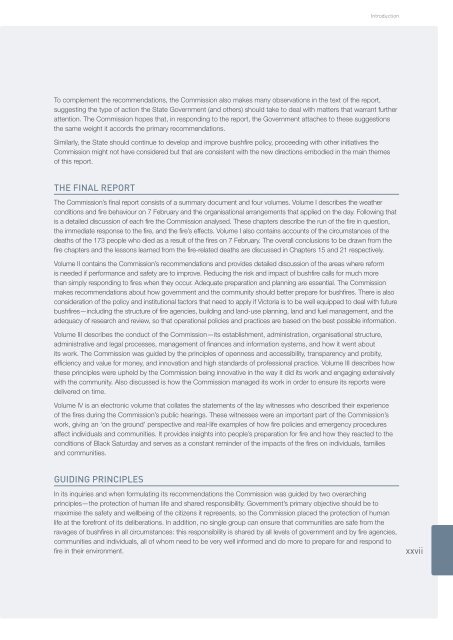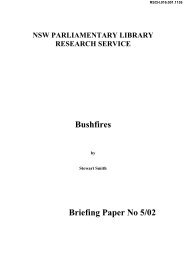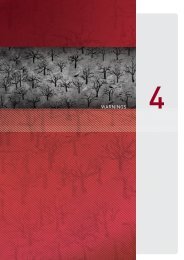The Fires and The Fire-relaTed deaThs - 2009 Victorian Bushfires ...
The Fires and The Fire-relaTed deaThs - 2009 Victorian Bushfires ...
The Fires and The Fire-relaTed deaThs - 2009 Victorian Bushfires ...
Create successful ePaper yourself
Turn your PDF publications into a flip-book with our unique Google optimized e-Paper software.
Introduction<br />
To complement the recommendations, the Commission also makes many observations in the text of the report,<br />
suggesting the type of action the State Government (<strong>and</strong> others) should take to deal with matters that warrant further<br />
attention. <strong>The</strong> Commission hopes that, in responding to the report, the Government attaches to these suggestions<br />
the same weight it accords the primary recommendations.<br />
Similarly, the State should continue to develop <strong>and</strong> improve bushfire policy, proceeding with other initiatives the<br />
Commission might not have considered but that are consistent with the new directions embodied in the main themes<br />
of this report.<br />
<strong>The</strong> final report<br />
<strong>The</strong> Commission’s final report consists of a summary document <strong>and</strong> four volumes. Volume I describes the weather<br />
conditions <strong>and</strong> fire behaviour on 7 February <strong>and</strong> the organisational arrangements that applied on the day. Following that<br />
is a detailed discussion of each fire the Commission analysed. <strong>The</strong>se chapters describe the run of the fire in question,<br />
the immediate response to the fire, <strong>and</strong> the fire’s effects. Volume I also contains accounts of the circumstances of the<br />
deaths of the 173 people who died as a result of the fires on 7 February. <strong>The</strong> overall conclusions to be drawn from the<br />
fire chapters <strong>and</strong> the lessons learned from the fire-related deaths are discussed in Chapters 15 <strong>and</strong> 21 respectively.<br />
Volume II contains the Commission’s recommendations <strong>and</strong> provides detailed discussion of the areas where reform<br />
is needed if performance <strong>and</strong> safety are to improve. Reducing the risk <strong>and</strong> impact of bushfire calls for much more<br />
than simply responding to fires when they occur. Adequate preparation <strong>and</strong> planning are essential. <strong>The</strong> Commission<br />
makes recommendations about how government <strong>and</strong> the community should better prepare for bushfires. <strong>The</strong>re is also<br />
consideration of the policy <strong>and</strong> institutional factors that need to apply if Victoria is to be well equipped to deal with future<br />
bushfires—including the structure of fire agencies, building <strong>and</strong> l<strong>and</strong>-use planning, l<strong>and</strong> <strong>and</strong> fuel management, <strong>and</strong> the<br />
adequacy of research <strong>and</strong> review, so that operational policies <strong>and</strong> practices are based on the best possible information.<br />
Volume III describes the conduct of the Commission—its establishment, administration, organisational structure,<br />
administrative <strong>and</strong> legal processes, management of finances <strong>and</strong> information systems, <strong>and</strong> how it went about<br />
its work. <strong>The</strong> Commission was guided by the principles of openness <strong>and</strong> accessibility, transparency <strong>and</strong> probity,<br />
efficiency <strong>and</strong> value for money, <strong>and</strong> innovation <strong>and</strong> high st<strong>and</strong>ards of professional practice. Volume III describes how<br />
these principles were upheld by the Commission being innovative in the way it did its work <strong>and</strong> engaging extensively<br />
with the community. Also discussed is how the Commission managed its work in order to ensure its reports were<br />
delivered on time.<br />
Volume IV is an electronic volume that collates the statements of the lay witnesses who described their experience<br />
of the fires during the Commission’s public hearings. <strong>The</strong>se witnesses were an important part of the Commission’s<br />
work, giving an ‘on the ground’ perspective <strong>and</strong> real-life examples of how fire policies <strong>and</strong> emergency procedures<br />
affect individuals <strong>and</strong> communities. It provides insights into people’s preparation for fire <strong>and</strong> how they reacted to the<br />
conditions of Black Saturday <strong>and</strong> serves as a constant reminder of the impacts of the fires on individuals, families<br />
<strong>and</strong> communities.<br />
Guiding principles<br />
In its inquiries <strong>and</strong> when formulating its recommendations the Commission was guided by two overarching<br />
principles—the protection of human life <strong>and</strong> shared responsibility. Government’s primary objective should be to<br />
maximise the safety <strong>and</strong> wellbeing of the citizens it represents, so the Commission placed the protection of human<br />
life at the forefront of its deliberations. In addition, no single group can ensure that communities are safe from the<br />
ravages of bushfires in all circumstances: this responsibility is shared by all levels of government <strong>and</strong> by fire agencies,<br />
communities <strong>and</strong> individuals, all of whom need to be very well informed <strong>and</strong> do more to prepare for <strong>and</strong> respond to<br />
fire in their environment.<br />
xxvii
















